The ideal size of a raid and cruising dinghy for one or 2 two persons
123
123
|
|
This post was updated on .
David
Please post photos etc. of your Aber build. The balanced lug is a good idea. I´ve even been in contact with Vivier asking for the same option. I agree, that Vivier has a lot of very nice boats. 
|

|
Francois Vivier |
Re: The ideal size of a raid and cruising dinghy for one or 2 two persons
|
|
Thank you for your comments on my designs and the Aber in particular.
Please note that my prices include full assistance by phone or e-mail during construction.
Kind regards
7 avenue des Courtils - 44380 Pornichet - France Tel : 33 (0)2 28 54 97 86 - Mobile : 33 (0) 6 74 54 18 60 2011/1/6 Anders [via UK HBBR Forum] <[hidden email]> David
François Vivier Naval Architect
|
|
|

|
Chris Waite |
Re: The ideal size of a raid and cruising dinghy for one or 2 two persons
|
|
Sorry this is late in the day, Anders and Others
My cunning plan for mini-raiding goes like this. I was suggesting a tad under twelve foot-ish, as the strakes could then be from one and a half sheet-lengths of ply. What I have produced is a model which is based on a ‘flattie’, but with a make over, in line with my urge to curve. It still has the same number of potentially stitch and tape seams – two chines, round the transom and the stem, which will extend under the forefoot. But this has a rounded hull forward (and actually, if you want to go groovy, almost whatever shapely transom your little heart desires; take a look at my rowing skiff ‘Octavia’). For the cameras, I mocked up a foredeck and a mast, ignore the 'building frame' remaining inside the hull, if you would:  So think of a simple (‘Gloucester’ – thanks Graham), Grand Banks, stacking dory. For rowing, someone was urging a narrow waterline beam, which these craft have and I am working on just over a metre, thirty-nine inches; the maximum beam at the gunwales is four and a half feet. But give it a vertical stem like a flattie for longer waterline length and at least a flattie transom as well but higher to keep it out of the water while you are rowing. It still has a flat bottom; simple to build and if you dry out, it won’t roll over. The deep curved forefoot maintains waterline length, gives grip and prevents slamming.  Now, a boat with that narrow a waterline is not terribly stable for sailing, but the dory is known to harden up considerably once it has a few hundredweight of fish on board; in other words, ballast and this would be my compromise. I have not used water ballast before, but I think this is the best alternative in view of the extremely varied requirements. This notion is a direct result of loading up Wayne Oliver’s flattie Oystercatcher ‘Ever Hopeful’, with hoards of hairy old HBBRers. I reckoned she needed some ballast, but I was amazed at the difference some half a dozen salty seamen made. 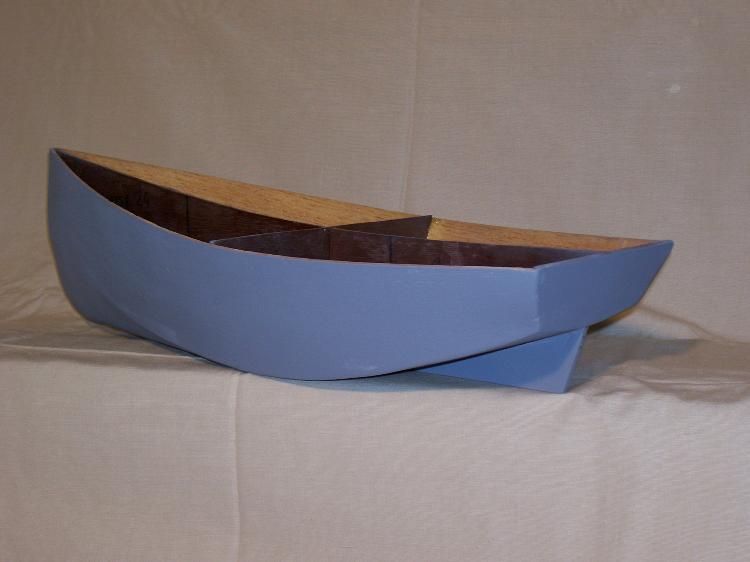 How would I do this? Almost all water-ballasted dinghies that I have come across have floodable compartments. This is OK, but the compartments need to be made watertight and it is difficult to maintain the interiors, also to empty them entirely. However, Plastimo (for instance) sell flexible water tanks and I think I would be inclined to have one under the floor boards, each side of the centreplate case. 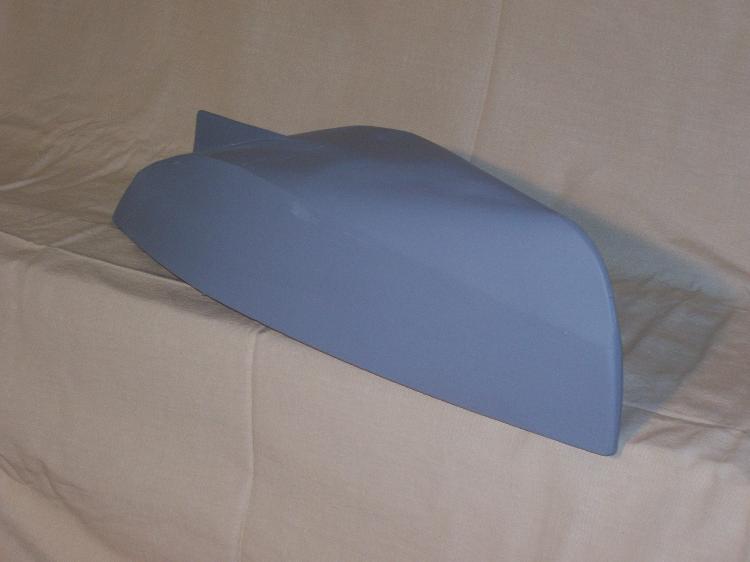 Each would have its own shut-off valve and these would be connected to a central hose, bottom end through a skin fitting valve under the hull and the top to a bilge pump, no air directly involved. This would allow you to flood both, straight from the sea and if necessary empty them the same way on hauling out, or pump out if no longer required, while still afloat. However it would also allow you to fill one only and using the valves, swap sides for long tacks, or bunk down on the opposite side of the case to maintain some semblance of an even keel. I have not yet come up with a reason why it should not prove to be a very flexible system. 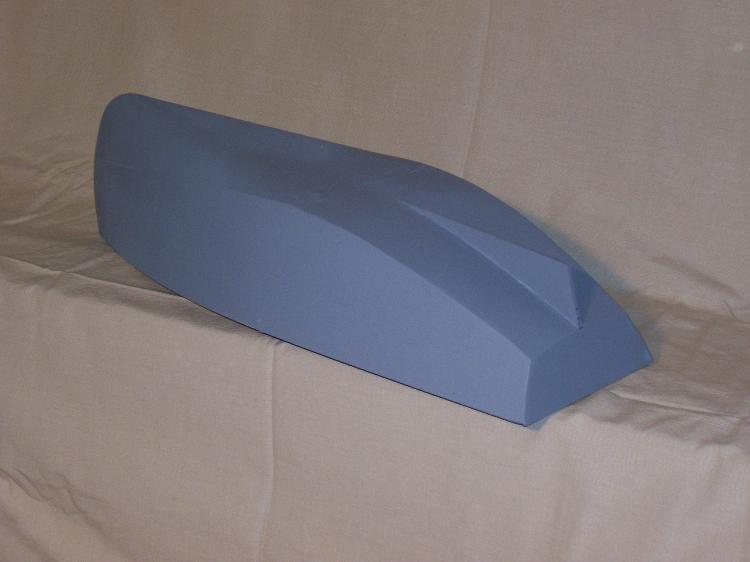 So these pictures are of the model equating to eleven foot six inches, with a shallow and only slightly rounded transom. I have done some float tests and it seems that to bring her down to equivalent of a ten and a half inch (270 mm) draft with the base of the transom touching the water, including all crew, kit and water ballast, she would need an all-up weight of nearly five hundred kilos. This reduces by roughly one hundred kilos for every one and a half inches (40 mm) of reduced draft. So that a seven and a half inch draft would support three hundred kilos; just about you, the boat, your kit, and a slosh or two of water ballast. The transom would benefit from being deeper in these cases to maintain waterline length, even if it did increase the buoyancy a tad as it deepened. The rig? I agree with the choice of balance lug, it has to be the simplest, handiest, most effective sail I can think of. I have one my current dinghy; it has four clips and I can have it rigged and ready to launch from lying alongside the boat, in three minutes. The idea of a yawl on something as long and unstable as a canoe is very reasonable, but on any moderate sized dinghy, I reckon more than one mast is just more hassle, with reduced power and extra windage thrown in. Chris Waite |
|
|
Thats an interesting concept. And I hope you´ll build it and post pictures.
Personally, I wouldnt lift the transom so much. I kinds of make the hull smaller with less bouyancy in the rear. Small boats are very picky with change of weight position. I´m preparing the building of a dink more or less the same size (Mirror class). 11´2 x 4´6. Its a smaller version of Campion boats Iceni 12. It´ll be an Iceni 11. Tom Dunderdale has made the new planks, moulds and building jig setup and I´m working on the interior layout and sail plan. More about that when I start doing something practical. I havent decided on building it S&T or Clinker. |

|
Paul H (admin) |
Re: The ideal size of a raid and cruising dinghy for one or 2 two persons
|
|
In reply to this post by Chris Waite
Cee Dubs (or Chris IV) (or Chris),
It looks like Santa's little helpers have been busy recently - I do like the model. Have you floated her with weight on board? Like Anders I think with gear towards the back, an outboard perhaps, she might drag her heels. All the gear would have to be stowed forward, but since you have ideas on a small cuddy that makes sense. cheers Paul |

|
Chris Waite |
Re: The ideal size of a raid and cruising dinghy for one or 2 two persons
|
|
In reply to this post by Anders
Ha Anders, you've caught me in the act!
I was hoping to pass this off as lifting the aft sections and transom clear of the water to reduce drag when rowing and did suggest in the text that a deeper transom would be appropriate in line with the all-up weight an individual reckons on. I also agree that dinghies are very sensitive to weight distribution; the fortunate thing about that is the crew can position themselves to get the best out of the boat in any given situation. I have actually raced a number of class dinghies in the preceding decades and the attitude/pitch of the hull fore and aft is at least as important as any moderate angle of heel. With a raid/cruising dinghy it would be best to get an ideal thwart position for rowing at least as this is difficult to adjust later and even space to sit comfortably when under sail needs to be considered. I have a whole heap more ideas on thwarts (there shouldn't be any fixed ones - they just get in the way) and other details. It is a shame that with modern materials wooden dinghy design has not really kept up, so there are often traditional seats (originally necessary to brace the hull), which take no account of the comfort, or even body shape and certainly not trim. However, I have to admit the real reason that the transom is so shallow on the model is that the notion, the 'Premise', behind this hull was to be suitable for a series of lengths based on the size of a standard sheet of ply, (with ballasting in mind). Though I dressed, talked about it and would like to build it as a twelve footer, I really wanted to check what would happen at double the dimensions so that it became a twenty-four foot gaff cutter for me to liveaboard, (given half a chance). The answer after floation trials is the displacment would be nearly four tonnes. The model is twenty-four inches long, so whatever it weighs ballasted down to its marks, that is 2.2kg, x6 x6 x6 is the displacment for the twelve foot hull; I removed ballast to reduce the draft by a quarter of an inch a time to get a rough idea of the reduced all-up weights mentioned in my last post. So 2.2kg x12 x12 x12 for the twenty-four footer and here is the plan: 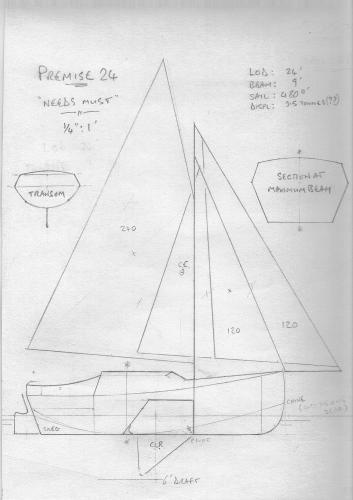 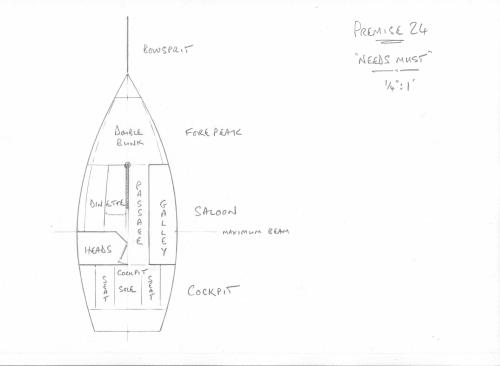 Draft with plate up twenty-one inches; plate down, six foot. Sorry to mix and match metric and imperial, but having been a 'Child of the Conversions', that is where my delapidated old bonce takes me. It's like the Winnie the Pooh bit about Pounds, Shillings and Ounces Chris Waite |
|
|
I have a whole heap more ideas on thwarts (there shouldn't be any fixed ones - they just get in the way) and other details. It is a shame that with modern materials wooden dinghy design has not really kept up, so there are often traditional seats (originally necessary to brace the hull), which take no account of the comfort, or even body shape and certainly not trim.
I´m looking forward to seeing some of your interior ideas. On a small sail and oar dink, I find that finding space for the oars inside the hull, so that they are not in the way when you sail, is pretty difficult. |

|
Chris Waite |
Re: The ideal size of a raid and cruising dinghy for one or 2 two persons
|
|
 You caught me 'on the hop' again Anders! I converted a little open 10' 4" (3.15 metre) GRP dinghy some fifteen years ago now. She came in the last stages of disrepair with broken, delaminating plywood thwarts a dagger board and fixed rudder, but a stayed Bermudan rig, with jib and even a spinnaker. Not a personal choice for such a small boat, so I stripped her down to the GRP shell and rebuilt her with a foredeck and substantial coaming, a hinged centreplate and rudder and finished her with an unstaid balance lug. She has been a tremendous little knock-about dinghy and as things have progressed, including my meeting the HBBR gang and even joining the DCA, I have been thinking more and more about smaller and smaller cruising dinghies, mini-raiders in fact. As explained further back in this topic, I have sketched up my ideas for a hull which would work at twelve feet and at twenty-four feet; I have now built both boats so many times in my head, I cannot for the life of me decide which to do.  In the meantime I would like something that will do a river, or sheltered coastal cruise, that I can drag up a beach, also camp in; the smaller the boat the more the fun. Wasn't it Hereshoff that reckoned he got the most pleasure out of a canoe with a single paddle? So 'Rosie Mae' has spent the last few weeks in the garage getting herself 'refreshed' a little. This means chasing a minor leak somewhere around the plate-case, I think and fitting a bunk, yes a bunk. You asked about my ideas for the interior of a dinghy. She has a beam of only 4' 6" (1.37 metres), but like so many of my creations, is overbuilt and fully rigged, weighs in at some 340 lbs (155 kg). I am putting in some pictures I have just taken of the interior - firstly empty so that you can see the amount of space available even in this small boat with a substantial foredeck. As she is so heavy, it is quite reasonable to stand up and wander around in her and I can walk forward and reef, or take the mast out of her while approaching a bridge for instance, without having to tie up, or worry that she will dump me overboard.  You asked about how people stow oars, well in my sixteen foot gaffer, I have a 9' pair which are jointed and while very useful for stowage, the fiddling around is a complete pain in the nethers - so much so that when I am cruising, I tend to keep one set-up to scull in and out of tight corners and leave it poking out astern while under sail. 'Rosie Mae' has 6' 6" (2 metres) of uninterrupted space on her floor boards and a set of oars lying there as shown. They are fine to row across the creek or similar, but if you are going to spend a day or more going down the river then 8' (2.44 metres) would be much better and I think for the Thames, after Beale this year, I hope to take a pair and tie them outboard of the coaming if I get the chance to do any sailing. For the 12' Premise I am considering making a blind-ended tubular hole under the forward buoyancy tank so that I can insert the ends of longer oars right up forward and lay them down the same as the shorter ones are shown here. 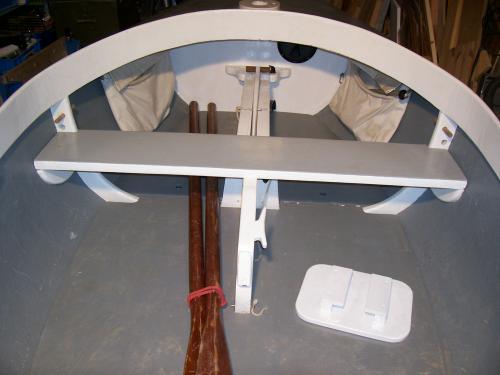 Buoyancy next while we are on the subject. Both this dinghy and my rowing skiff 'Octavia' have buoyancy tanks that are largely confined to each end of the boat. The reasoning is that this ensures(oh yes?) neither end will sink. If you have buoyancy under foot, or on either side, then the boat will tend to be at least as stable upside down as she is upright - awkward if you are contemplating going any further after a capsize. The next thing is that this boat and the Premise 12 have tanks that come right up to gunwale level (OK, not the stern in Rosie Mae, but she was not planned quite for this). Both hulls are also notably deep; this means that there is a lot of air trapped up at gunwale level, all trying to turn you upright - particularly if your kit is tied down in the bottom of the boat. Now for me this is only a theory, but the reason that RNLI lifeboats look unusually tall is for just this reason - the buoyancy in the superstructure tends to stop them inverting completely and to throw them back upright and they have tried it - they are unstable upside down. They also have sophisticated self-righting tanks that are probably beyond the remit of the average HBBRite.  Back to this little interior. I have a rowing stool which slips onto the back end of the plate case as shown as well as a traditional thwart, which is also entirely removable. I almost never use the thwart and it lies on the floor boards - just where my missus and I prefer to sit. The boat really appreciates us keeping our weight low, and to anyone who hasn't tried it, I seriously suggest you do, the feeling of stability is phenomenal. The other thing I have done is to cut a couple of heel holes into the aft floorboard to brace myself for rowing. Not ajustable, but I am hoping my legs will stay about the same length for the next while. Finally, sleeping; the oar length space allows me to stretch out without having to insert myself under a fixed thwart. Off-centre I know, but quite low anyway and this dinghy is heavy enough not to heel much, though I would put my kit well over to port and have considered a collapsible camping water bag, with sea in it, tied to the port coaming, if the heel makes me feel uncomfortable. So here is a picture of the bunk - a really comfy hammock (siesta this afternoon), with a few extra struts that takes only a few minutes to set up.  Like it? Chris Waite |
|
|
In reply to this post by Chris Waite
I like the open layout of your dinghy. Looks very spacy. I´m not sure though that its the best for a lighter dinghy (40kg hull weight)
Here you have a drawing of a layout I´ve made for a Iceni 11 (campion boats) The rear seat can be lifted so that the oars can be underneath the overhang of the sidebenches/bouyancy tanks 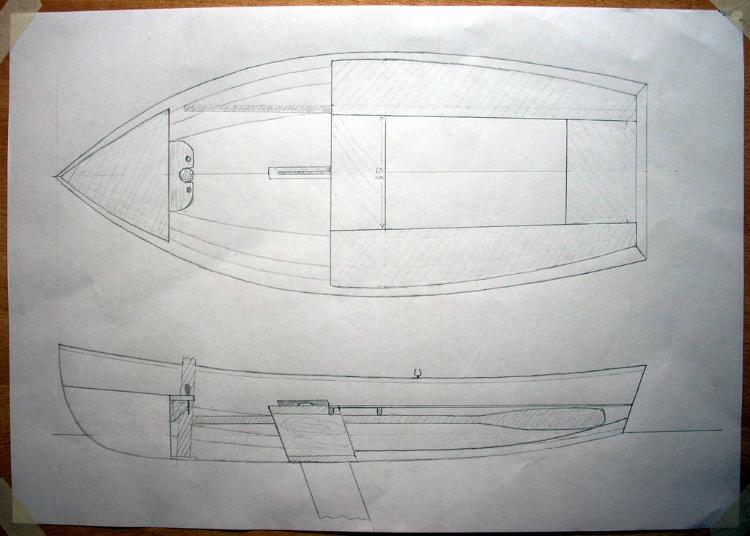
|

|
Francois Vivier |
Re: The ideal size of a raid and cruising dinghy for one or 2 two persons
|
|
I would like to inform you that the French magazine Chasse-Marée is organising a design competition. The aim is a light raid dinghy. See the Chasse-Marée web site, unfortunetely in French only: http://www.chasse-maree.com/Articles-divers/concours-naviguer-leger.html
Project are to be sent for end April. I intend to propose a new design, but of course you will have to wait to see it! As already said on this forum, I have to draw a lug sloop rig and also a sprit sail option for Aber. They will be done shortly and I will post a news when done. I see that some are considering small boats, as small as 11' for single handed raid. You may have a look on my Morbic 12 which has not been quoted until now : http://www.vivierboats.com/html/stock_sail_and_oar.html#morbic12 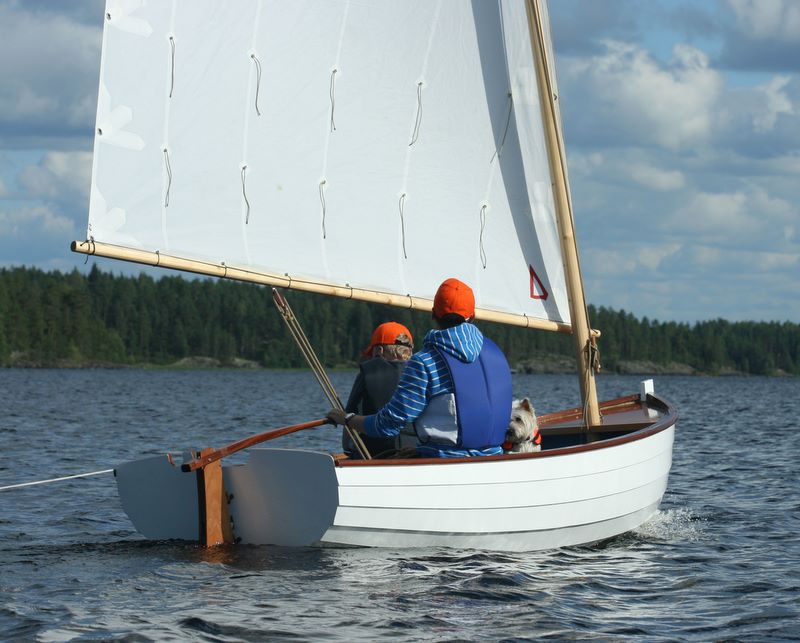 A Morbic 12 is presently under construction in UK by Adrian Donovan (http://www.adriandonovan.co.uk/) using a NC cut kit made by Jordan boat. It is also possible to build this boat using full size paterns, which needs more building time but less expense. I am conscious that "commercial" posts are generally not welcome on forum and I hope you will consider this one as mainly giving information to everybody profit. Kind regards
François Vivier Naval Architect
|
|
|
Thankyou Francois for posting this. I went and had a look immediately.
My French is practically non existent (and my conversational Chinese is useless!  ) so I checked it with both google translation and babelfish. ) so I checked it with both google translation and babelfish.
I only have one concern about this - that the magazine doesn't seem to limit its rights to only publish in the magazine or promotional material, or protect the ownership of the designer. Maybe there is a part of French Law or copyright law that is well known so they don't need to mention but maybe not. Possibly "libre de droit" has a specific meaning in this way. Something like the copyright law "fair use" that would allow publishing but restrict say, plan sales or publishing the plans for free in the magazine. From Google translate It is also possible to present a half-shells, models, sketches, watercolor views, etc. All the documents must be provided on paper. A digital version will also be appreciated. Chasse-Maree and Wood Village Grand Pavois reserve the right to reproduce and publish the plans submitted to the contest and writing projects, each item submitted (plans, specifications, etc..) By a participant is recognized by it "Royalty free" for organizers. Here is the French text so those who can read directly can see directly whether there is a legitimate concern in this area. Il sera également possible de présenter demi-coques, maquettes, croquis, vues aquarellées, etc. L’ensemble des pièces du dossier devra être fourni sur papier. Une version numérique sera également appréciée. Le Chasse-Marée et le Village bois du Grand Pavois se réservent le droit de reproduire et publier les plans soumis au concours ainsi que la rédaction des projets, chaque élément présenté (plans, cahier des charges, etc.) par un participant étant reconnu par celui-ci “libre de droit” pour les organisateurs. Best wishes Michael |

|
Francois Vivier |
Re: The ideal size of a raid and cruising dinghy for one or 2 two persons
|
|
I do not think chasse-Marée has asked advice of a layer for this design competition, but I am sure they do not intend to ask more than the right to publish the drawings, pictures, etc... they will receive and no more. The right of the designer is kept entire. The only thing which may unpleased some designers is that they will publish the line plan.
François Vivier Naval Architect
|
|
|
Hi,
I am sure there is no evil intention! But once rights are given away they can be hard to get back. If I do enter I will write and ask for a clarification. Thanks Francois Michael |

|
Port-Na-Storm |
Re: The ideal size of a raid and cruising dinghy for one or 2 two persons
|
|
In reply to this post by Francois Vivier
Hello Francoise,
I for one don't have any problem if an occasional post is slightly commercial. Its great to have your input. The Morbic12 was high on my list of possibilities before I decided on building the Coot. Maybe one day I'll build one, or an Aber, or a Beg Meil. So many boats so little time! I tried translating the rules of the competition but it seemed to lose something in the translation. I'm not sure if you have to carry the boat for two days or just the one.  It'll be interesting to see the results. regards Graham |

|
simplesimon |
Re: The ideal size of a raid and cruising dinghy for one or 2 two persons
|
|
In reply to this post by boatmik
Thank you Francois
I read the offending paragraph as requiring a free licence to publish, but I may be wrong. One thing that does puzzle me - the reference to "(un) seul permis A". ["Le transport routier devra être accessible aux titulaires du seul permis A. ] I may be wrong but AFAIK a Category A licence is for motorcycles! Does this refer to the "permis probatoire" (holders of which have to display an "A" plate on the vehicle) and if so what does that allow you to carry on your car, or perhaps more importantly, trail behind it? 750kg gross? Can anyone shed light on this? Merci Simon |

|
Michael Rogers |
Re: The ideal size of a raid and cruising dinghy for one or 2 two persons
|
|
In reply to this post by Anders
GREAT topic - like asking a collection of petrolheads what their favourite car is!
A cruising dinghy is all sorts of compromises, ditto one for raiding. And combining the two - mmm.... One issue is why one raids - for the 'togetherness', or to win? I haven't been raiding yet: I hoped to do the English (Solent) Raid last summer, but couldn't fit it in. Perhaps this summer. (I used to sail a Heron out of Keyhaven.) Even if one raids sociably, I'm sure the urge to 'race' comes up at times! Of established boats, I think the Heron and the various Wight/Lymington/Keyhaven scows deserve an honourable mention in this discussion. My present boat is a 14 ft double-ender, a Swallowboats Storm Petrel, kit-built at home in 2004, and sailed with great enjoyment since (picture in my 'Introducing myself' thread). However, she is not great for either cruising or potential raiding for two reasons - 1) she is very tender, and with no side decks and low freeboard this is a problem in gusty conditions. 2) She is not great to row: the hull is extremely driveable with oars, and I love rowing, but there isn't a comfortable rowing position, especially for long hauls, and balance is impossible with more than one aboard, because of her tippability. I'm about to start kit-building a Swallowboats Trouper 12 (can be seen at www.swallowboats.com), which is light, beamy and stable (5' 3" beam on 12 ft LOA - Mr U Fox would NOT approve), with a partly flat bottom for which I have downwind hopes. She will be junk rigged. Those of you who are DCA members will shortly be able to read about my 'conversion' to this rig, and I should warn folks that, based on my practical experience of its many advantages, I am full of missionary zeal on the subject. I look forward to cruising and 'sociable-raiding' in my new boat when she is ready (I hope 2011, but experience of build timetables suggests 2012), and I am confident that those who meet her will be surprised by her performance. |

|
Francois Vivier |
Re: The ideal size of a raid and cruising dinghy for one or 2 two persons
|
|
In reply to this post by simplesimon
Driving licence A is a mistake. Chasse-Marée has published an erratum but they have not update the web site. So you have to read Licence B, which means thant the boat is to light enough not to require Licence E (for heavy trailers). In pratice, this means a boat under 800 to 1000 kg...
François Vivier Naval Architect
|

|
Francois Vivier |
Re: The ideal size of a raid and cruising dinghy for one or 2 two persons
|
|
In reply to this post by Port-Na-Storm
This is a free translation of the main items of the Chasse-Marée raid boat design competition :
To allow coastal raid, during 2 days or more, for a crew from 1 to 4 people (at designer option). During the raid, handling ashore must be done by the crew itself, wihout exterior help or exterior equipement. The boat is propelled only by the human force or the wind. It must be possible to shift from sail (wind propulsion) to oar (human power), or vice-versa, at sea, without need to come back to shore. The boat must comply to EC rules, category D or C at designer option. The crew must embark the safety equipement, as required by applicable rules (they have in mind French rules, but there is nothing special inot them). Trailering with driving licence B only. Easy launching and recovering will be taken in account. The judges will take in account performances both under sail and under oars. Building material are free, but sustainable development will be taken in account.
François Vivier Naval Architect
|

|
simplesimon |
Re: The ideal size of a raid and cruising dinghy for one or 2 two persons
|
|
In reply to this post by Francois Vivier
Merci bien
Simon |
«
Return to General Discussion
|
1 view|%1 views
| Free forum by Nabble | Edit this page |
